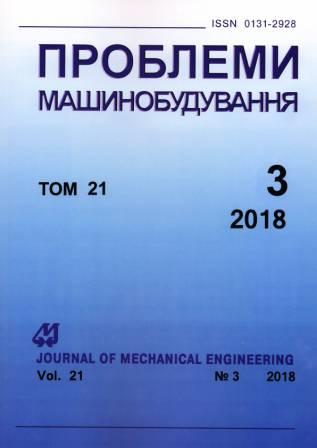Influence of Thermal and Mechanical Factors on the Stressed State of Large Components of Hydrogenerator-Motors
Keywords:
hydrogenerator, mechanical stresses, thermal process, metal defectsAbstract
The work presented contains a detailed analysis of the existing ultimate power air-cooled hydrogenerator-motor design. It is shown that the umbrella-type hydrogenerator crosspiece perceives dynamic loads caused by forces acting in three planes. At the same time, to take them into account by analytical methods is impossible. In order to perform a three-dimensional calculation, it is necessary to take into account both the thermal and mechanical factors, as well as the specific features of the rolled metal. In the course of solving the problem set out above, taking into account thermal loads, a discrete crosspiece partition into the n-th number of sections is proposed. The convergence criterion for the solution to the inverse problem is based on maintaining the structure overall thermal balance, taking into account the limited accuracy of measuring devices. The main difference of the work was the justification of the choice of permissible stresses, taking into account the presence of bubbles in the metal structure, not exceeding their class of continuity for the selected rolled metal. It is proposed that an 'elementary defect' be introduced into the zone with the lowest safety margins as a circle with geometric data according to the restrictions on continuity. In this case, the correction of the selection of the finite element mesh parameters for the introduced defect is carried out as for the plate with eccentrically located holes. The mesh reduction continues to be carried out until the moment when the difference in the maximum stresses in the same mesh nodes is no more than 0.04%. Mechanical loads are specified in the classical formulation. In the course of the work it was found that the strength reserves of large generator components should be regulated by the quality of the rolled metal used, and the mechanical calculations should take into account thermal factors.References
Tretiak, O. V., Shut, O. Yu., & Trybushnoi, M. V. (2017). Analiz teplovoho stanu khrestovyny hidroheneratora – dvyhuna velykoyi potuzhnosti za osoblyvykh umov ekspluatatsii [Analysis of the thermal state of a hydrogenerator crosspiece − a high-power engine under special operational conditions.]. Visnyk NTU «KhPI». Ser.: Enerhetychni ta Teplotekhnichni Protsesy i Ustatkuvannya − Bulletin of the NTU 'KhPI'. Series: Power and Heat Engineering Processes and Equipment, no. 11 (1233), pp. 49–54 [in Ukrainian].
Tretyak, A. V., Shut, A. Yu., Gakal, P. G., & Poliyenko, V. R. (2017). Osobennosti matematicheskogo modelirovaniya teplovogo sostoyaniya gidrogeneratorov kapsulnogo tipa [Features of mathematical modeling of the thermal state of capsule-type hydrogenerators]. Vіsn. NTU 'KhPI'. Ser. Elektrichni Mashiny ta Elektromekhanichne Peretvorennia Enerhii − Bulletin of the NTU 'KhPI'. Series: Electric Machines and Electromechanical Energy Conversion, no. 10 (1232), pp. 44-51 [in Russian].
Krasnykh, V. Yu., & Korolev, V. N. (2012). Teplomassoobmen. Osnovnyye formuly, zadachi i sposoby ikh resheniya: sb. zadach [Heat and mass transfer. Basic formulas, problems and ways of their solution: problem collection]. Yekaterinburg: Ural. federal. un-t, 64 p. [in Russian].
Tekhnologiya proizvodstva metalloprokata. Defekt metalla 'Rakoviny ot okaliny' [Technology of production of rolled metal. Metal defect 'Shells from dross'] Available at: http://metallopraktik.ru/novosti/defekt-metalla-rakovinyi-ot-okalinyi/ (accessed5 July 2018) [in Russian].
Downloads
Published
Issue
Section
License
Copyright (c) 2018 Aleksey V. Tretyak, Aleksandr Yu. Shut, Pavel G. Gakal

This work is licensed under a Creative Commons Attribution-NoDerivatives 4.0 International License.
All authors agree with the following conditions:
- The authors reserve the right to claim authorship of their work and transfer to the journal the right of first publication of the work under the license agreement (the agreement).
- Authors have a right to conclude independently additional agreement on non-exclusive spreading the work in the form in which it was published by the jpurnal (for example, to place the work in institution repository or to publish as a part of a monograph), providing a link to the first publication of the work in this journal.
- Journal policy allows authors to place the manuscript in the Internet (for example, in the institution repository or on a personal web sites) both before its submission to the editorial board and during its editorial processing, as this ensures the productive scientific discussion and impact positively on the efficiency and dynamics of citation of published work (see The Effect of Open Access).

